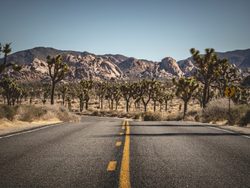
Joshua Tree National Park
Quick Navigation
Joshua Tree National Park is located in corner of southeastern part of California. The park covers an area of 1,235.4 square miles (3,199 sq km). Approximately half of the park is recognized as a wilderness area.
The park is comprised of two separate desert ecosystems, which are primarily influenced by elevation. The Colorado Desert represents the lower altitude while the Mojave Desert is the higher.
The vegetation varies as well featuring creosote bush, shrubland, juniper and pinyon pine, and the montane forest. However, the protected area is renowned for the Joshua Trees which is where the name of the park is drawn. The Joshua Tree is native to and only found in the Mojave Desert region. The higher elevations and subsequently cooler temperatures serve as the unique ecosystem which sustains the Joshua Tree (Yucca brevifolia).
The park landscape also features stunning rock formations that usually present as bare rocks and random boulders. There are five different mountain ranges which include: Cottonwood, Eagle, Hexie, Little San Bernardino, Pinto, and Traverse.
The Colorado Desert portion of the park features an ecosystem below 3,000 feet (910 m) which gives way to many of the other vegetation species. Cholla cactus and yucca are some of the most prominent and intriguing species. The Coachella Valley found on the southeast side of the Colorado Desert is even lower and features a mixture of grasslands and desert dunes.
There are over 250 species of birds living or migrating through the park. This makes it a birdwatcher’s haven. Of course, one of the desert highlights is the roadrunner; just remember “The coyotes after you.” Golden eagles are another bird species highlight.
Some of the other potential wildlife to see in Joshua Tree National Park include bighorn sheep, coyote, lynx, mule deer, kangaroo rat, desert tortoise, and a variety of snakes.
Much of the park has to be experienced through the numerous hiking trails, however, there is a scenic drive that cuts across the park allowing visiting to witness most of what the park has to offer. There is a similar feeling to the saguaros of Saguaro National Park in Arizona.
Highlights
The park delivers two unique desert ecosystems and there is quite a difference in the presentation and experience of both areas. The contrast is one of the highlights of the park along with the stunning boulder and Joshua Tree landscapes.
There are 5 desert palm oases located in the national park. The Oasis of Mara is one of the most popular, and it is easily accessed through the short Twentynine Palms trail.
Park Boulevard
 This is a scenic drive that traverses across the park. It provides insights into the majority of the scenic aspects of the park. One of the unique features of the Park Boulevard is the contrast in desert ecosystems you will witness as you drive up out of the Colorado Desert ecosystem crossing into the Mojave Desert ecosystem.
This is a scenic drive that traverses across the park. It provides insights into the majority of the scenic aspects of the park. One of the unique features of the Park Boulevard is the contrast in desert ecosystems you will witness as you drive up out of the Colorado Desert ecosystem crossing into the Mojave Desert ecosystem.
The drive through the park on Park Boulevard is one of the best ways to capture the serenity and uniqueness of the park. You cannot help but be mesmerized by the endless sea of Joshua Trees that blanket the landscape. It is one of the places where you ask, "Are they watching me?"
Joshua Tree National Park Trails
There are numerous trails to hike within the park. This is desert, so be prepared for warmer temperatures and drink lots of water.
Joshua Tree Highlights
- Park Boulevard
- Joshua Trees
- Oases
Park Map
Sources
- AllTrails, Best Trails in Joshua Tree National Park, https://www.alltrails.com/parks/us/california/joshua-tree-national-park, retrieved June 2020.
- Britannica, Joshua Tree National Park, https://www.britannica.com/place/Joshua-Tree-National-Park, retrieved June 2020.
- California Dream Big, Spotlight Joshua Tree National Park, https://www.visitcalifornia.com/destination/spotlight-joshua-tree-national-park, retrieved June 2020.
- Greater Palm Springs, Joshua Tree National Park, https://www.visitgreaterpalmsprings.com/play/things-to-do/joshua-tree-national-park/, retrieved June 2020.
- National Geographic, Everything to Know About Joshua Tree National Park, https://www.nationalgeographic.com/travel/national-parks/joshua-tree-national-park/, retrieved June 2020.
- National Geographic, Complete National Parks of the United States, National Geographic Publishing, Washington DC.
- National Geographic, Guide to the National Parks of the United States, National Geographic Society, 2003.
- National Geographic, National Parks of North America, Canada-United States-Mexico, National Geographic Society, 1995.
- National Park Service, Bryce Canyon, https://www.nps.gov/brca/index.htm, retrieved June 2020.
- Palm Springs, Joshua Tree, https://www.palmsprings.com/attractions/joshua-tree/, retrieved June 2020.
- Recreation, Joshua Tree National Park, https://www.recreation.gov/camping/gateways/2782, retrieved June 2020.














